Passover Desserts vs. Desserts for Passover
Years ago, I brought my (now) husband home to celebrate Passover with my relatives. While he had already met my immediate family, this was the first time he was going to be with the “whole mishpucha”. Needless to say, he was out to make a good impression. All was going great…. until dessert. My mother, being of the typical “we never have enough food” Jewish mother variety, had plenty of food and desserts. But she felt like she just needed that one more dessert, and had made a special, Kosher-for-Passover cake from the box. I warned Jesse not to touch it, that try as they might, the Jewish people had yet to perfect the “Passover Cake.” But, wanting to make that impression he took a nice healthy slice, after which he managed to choke out, “it’s not bad.” He would have gotten away scott-free had it not been for my brother. Mere seconds after Jesse uttered that the cake wasn’t bad, my brother, a bit “happy” after the requisite four glasses of wine, took a bite and shouted, “Ma, this sucks!” And he was right. Passover cakes, even the homemade ones, inevitably taste “funny” to terrible. It’s not anyone’s fault really. It’s just that when ingredients such as flour, baking powder/soda and yeast are replaced with potato starch and matzo meal along with more eggs and oil than normally consumed in a year, there is no way the food is going to taste very good let alone close to the original.
Over the years, I have made it my mission to try as many cookie, cake and brownie recipes that make the claim of being “fabulous” Passover desserts, from Bon Appetite Magazine to my Aunt Judy. I’ve tried the “flourless” chocolate cakes (that end up with an extremely heavy fudge-like consistency because even most flourless cakes have a bit of flour in them), the sponge cake (where even the addition of orange zest can’t mask the taste of matzo cake meal and potato starch), the brownies (where even the addition of egg whites whipped to frenzied peaks can’t make up for missing baking powder or soda). From cookies to brownies, I’ve tried them all and have come to the conclusion that they aren’t worth the bother. So now, when people ask me if I have a great Passover dessert recipe I respond no, but I DO have great dessert recipes that will work FOR Passover. I’ve decided to share a few with you below, so that you can add some fantastic flavor to your Passover dessert table. You’re welcome.
FROZEN STRAWBERRY MOUSSE*
Ingredients
• 1 quart fresh strawberries, hulled and halved
• 3/4 cup sugar
• 2 large egg whites
• 2 tablespoons lemon juice
• 3/4 cup sugar (in addition to the sugar above)
• Strawberries, for garnish
Directions
1. Puree strawberries and 3/4 cup sugar in blender or food processor.
2. Beat egg whites with lemon juice and gradually add additional 3/4 cup sugar until stiff peaks form.
3. Fold berry mixture into whites.
4. Beat at high speed for 10-15 minutes until mixture doubles in volume.
5. Pour into parfait glasses, jello mold (or graham cracker pie crust when it’s not Passover), cover and freeze for at least 24 hours.
6. Let stand 5-10 minutes before serving – garnish with berries, strawberry sauce and or whipped cream or cool whip.
*This makes a ton – you may even want to cut it in half.
CHOCOLATE BOWLS WITH WHITE CHOCOLATE STRAWBERRY MOUSSE
Bowls
• Balloons (I used water balloons because they are nice and small but you can use regular balloons just blown up part way)
• Semi sweet chocolate (or any kind of chocolate you prefer)
• Cooking spray.
Directions
1. Blow up the balloons, rinse them off and let them dry.
2. Line a baking sheet with wax paper or parchment paper.
3. Melt chocolate over a double boiler or carefully in the microwave. Pour into a small deep bowl and let it cool slightly.
4. Spray each balloon lightly with cooking spray.
5. Spoon small amounts of chocolate onto the baking sheet (equal to the number of bowls you plan on making). This will be your bowl base.
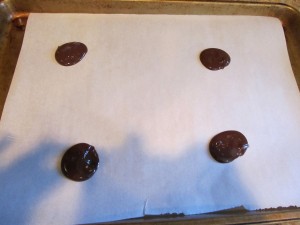
6. Take one of your prepared balloons and dip it in the chocolate. Dip it in enough so the chocolate makes a bowl shape around the balloon.
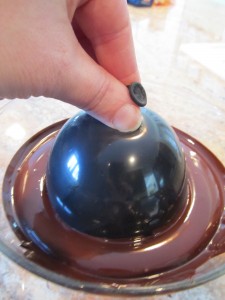
7. Remove from the chocolate and place the balloon gently on top of the chocolate waiting on the baking sheet.
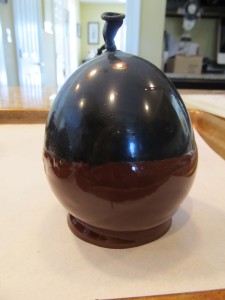
8. Repeat until you are out of chocolate or have as many bowls as you need. Place baking sheet in refrigerator for 15-20 minutes
9. Remove from fridge and pop a small hole in the balloons with a pin. Gently peel the deflated balloon from the chocolate.
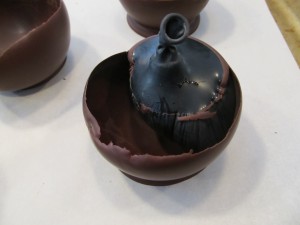
10. Store in the refrigerator until ready to serve. Fill with filling of your choice: pudding, mousse, ice cream, berries etc.
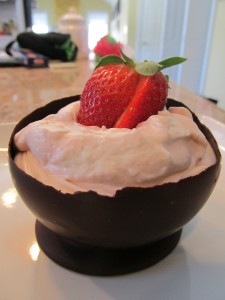
STRAWBERRY WHITE CHOCOLATE MOUSSE
(note: this recipe made enough to fill 5 chocolate balloons bowls)
Ingredients
• 1 lb. strawberries
• 1 Tbsp lemon juice
• 8 ounces white chocolate finely, chopped
• 1 1/4 tsp unflavored gelatin
• 2 cups whipping cream, divided
• 2 Tbsp powdered sugar
• Extra strawberries for garnish
Directions
1. Clean and hull the remaining strawberries then cut them in half.
2. Place the prepare strawberries in a blender or food processor and puree until smooth.
3. Using a fine sieve, press the puree through the sieve into a bowl. This is to remove the seeds. You want to have 3/4 a cup of puree. Once you have 3/4 cup puree, stir in the 1 Tbsp lemon juice. Set aside.
4. Place white chocolate in a microwave safe bowl. Microwave for 30 seconds and stir. Microwave in 20 second intervals until melted and smooth. Set aside.
5. Place 1/4 cup cold water in a small bowl and sprinkle with gelatin. Let sit for 5 minutes.
6. In a small sauce pan, heat 1/4 cup of the cream with the powdered sugar to a simmer over medium heat. Add the gelatin and stir until dissolved.
7. Remove from the heat and add the melted chocolate. Stir until well blended. Then whisk in the 3/4 cup strawberry puree.
8. Whip remaining whip cream with a hand mixer. Add 1/3 of the whipped cream to the chocolate mixture and whisk together until smooth.
9. Next, add the chocolate mixture to the remaining whipped cream and lightly fold in using a silicone spatula. Refrigerate for 1 hour.
BITTERSWEET CHOCOLATE PUDDING
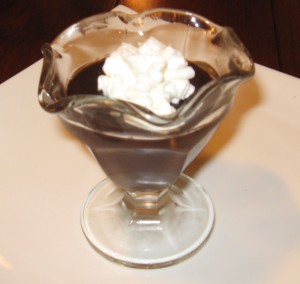
Ingredients
• 3 1/2 cups skim milk, divided
• 1 cup cocoa, dutch process
• 3 tablespoons cornstarch**
• 1/4 teaspoon salt
• 1 cup sugar
• 1 large egg, lightly beaten
• 1 large egg yolk, lightly beaten
• 2 ounces bittersweet chocolate, coarsely chopped
• 1 tablespoon vanilla extract
Directions
1. Combine 1 cup milk, cocoa, cornstarch, and salt in a large bowl; stir
well and set aside.
2. Cook 2 1/2 cups milk in a large heavy saucepan over medium-high heat to 180 degrees or until tiny bubbles appear around the edges (do not boil). Remove from heat; stir in sugar with a whisk until it dissolves. Add cocoa mixture to pan, stirring until blended. Bring to a boil over medium heat, cook 2 minutes, stirring constantly.
3. Combine egg and egg yolk in a bowl, stirring well with a whisk. Gradually add milk mixture to egg mixture, stirring constantly.
4. Return mixture to pan. Cook over medium heat until thick (about 2 minutes); stir constantly. Remove from heat. Stir in chocolate and vanilla. Stir until chocolate melts. Serve warm or chilled.
* For Passover, the Jewish tradition prohibits the eating of khametz, usually translated as “leaven” or “leavened bread.” Basically it refers to food prepared from five species of grain — wheat, barley, oats, spelt, and rye — that has been allowed to rise (Ieaven).
The Ashkenazic rabbis (probably around 10th or 11th Century AD) in Germany also prohibited what they called kitniot — basically, anything that was sold in grain-like form or might be confused with grain. Their prohibition included rice, millet, corn, and legumes. When in doubt, prohibit, on the grounds that it is better to be more strict in avoidance of foods than to be less strict and potentially violate the Biblical commandment not to eat leaven. Of course, corn (maize) was not known to Europe at the time, but when the New World crop made its appearance a few centuries later, it was quickly identified as kitniot and thus prohibited for Passover.
Sephardic Jews (from Spain and the Mediterranean areas) did not prohibit rice, millet, corn or legumes. They said there was no danger of confusing them with prohibited grains. So a cheesecake made for a Sephardic family might use cornstarch.
Read Our Recent Posts
You May Have Read About Us
- Jack and Salma blog calls our Lemon Drops “so sweet…”
- Skirt.com says we’re one of their “loves”
Sweet Little Friends
- Food Fixe Siobhan knows her stuff


